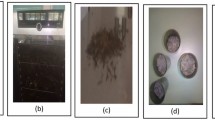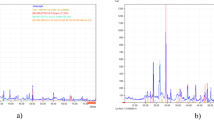Abstract
The limestone addition to sulfate resisting Portland (SR) cement is often used to adjust artificially the amount of aluminate (C3A) in order to keep it less than 3%. However, CaCO3 addition is well known to induce thaumasite formation (CaCO3·CaSO4·CaSiO3·15H2O) in Portland cement during external sulfate attack. This compound decreases the concrete durability because of its high volume expansion. In this work we studied the addition of limestone within low amounts (≤ 6.21%) into SR Portland cement. Thus, three commercial samples (A, B and C) containing limestone addition were analyzed by XRF technique and the results were used to estimate the mineralogical composition by Bogue method. XR diffraction coupled to Rietveld algorithm was then performed to determine the real amounts of mineralogical phases. The results were as following: C3S contents were 49.70, 45.30 and 50.60%; C3A: 1.40, 1.10 and 2.5% and calcium carbonate addition 6.21, 2.10 and 2.10%, respectively. The effect of calcium carbonate on hydration kinetics at early age has been studied and discussed. Durability of studied cement samples was followed during 2 years into Na2SO4 and MgSO4 solutions (10 g/L). Thaumasite formation was observed only in cement mortars corresponding to the sample 6.21% CaCO3, C3S (49.70%) and C3A (1.4%) at 22 °C, this result is different from earlier works in which thaumasite precipitates at low temperature (5 °C) and high CaCO3 contents (> 15%). This result proved the SR Portland cement must contain very low limestone addition, less than 6% and much lower if used at 5 °C or below.

















Similar content being viewed by others
Abbreviations
- C:
-
CaO
- S:
-
SiO2
- A:
-
Al2O3
- F:
-
Fe2O3
- N:
-
Na2O
- K:
-
K2O
- \( \bar{S} \) :
-
SO3
- M:
-
MgO
- H:
-
H2O
- LOI:
-
Loss in ignition
References
En N (2001) 197–1-Ciment—Partie 1: composition, spécifications et critères de conformité des ciments courants. AFNOR, Paris
Gollop R, Taylor H (1995) Microstructural and microanalytical studies of sulfate attack III Sulfate-resisting portland cement: Reactions with sodium and magnesium sulfate solutions. Cem Concr Res 25(7):1581–1590
IslemLabidi H (2017) Adel Megriche: feasibility of efficient RS Portland cement from An optimization combination of raw materials. J Tunis Chem Soc 19:294–300
Sorrentino F (2011) Chemistry and engineering of the production process: state of the art. Cem Concr Res 41(7):616–623
Chatterjee AK (2011) Chemistry and engineering of the clinkerization process—Incremental advances and lack of breakthroughs. Cem Concr Res 41(7):624–641
Hawkins P, Tennis P, Detwiler R (2003) The Use of Limestone in Portland Cement: a State-of-the-Art Review. Portland Cement Association, Skokie, Illinois, USA
Bonavetti V, Donza H, Rahhal V, Irassar E (2000) Influence of initial curing on the properties of concrete containing limestone blended cement. Cem Concr Res 30(5):703–708
Kakali G, Tsivilis S, Aggeli E, Bati M (2000) Hydration products of C3A, C3S and Portland cement in the presence of CaCO3. Cem Concr Res 30(7):1073–1077
Schmidt T (2007) Sulfate attack and the role of internal carbonate on the formation of thaumasite. Thesis EPFL, Lausanne, Switzerland
Schmidt T, Lothenbach B, Romer M, Neuenschwander J, Scrivener K (2009) Physical and microstructural aspects of sulfate attack on ordinary and limestone blended Portland cements. Cem Concr Res 39(12):1111–1121
Collepardi M (1999) Thaumasite formation and deterioration in historic buildings. Cement Concr Compos 21(2):147–154
Juel I, Herfort D, Gollop R, Konnerup-Madsen J, Jakobsen HJ, Skibsted J (2003) A thermodynamic model for predicting the stability of thaumasite. Cem Concr Compos 25(8):867–872
Crammond N (2002) The occurrence of thaumasite in modern construction—a review. Cem Concr Compos 24(3–4):393–402
Tsivilis S, Sotiriadis K, Skaropoulou A (2007) Thaumasite form of sulfate attack (TSA) in limestone cement pastes. J Eur Ceram Soc 27(2):1711–1714
Irassar E, Gonzalez M, Rahhal V (2000) Sulphate resistance of type V cements with limestone filler and natural pozzolana. Cem Concr Compos 22(5):361–368
Al-Amoudi OSB (2002) Attack on plain and blended cements exposed to aggressive sulfate environments. Cem Concr Compos 24(3):305–316
Islem Labidi SB, Houcine T, Adel M (2018) Critical research study of quantification methods of mineralogical phases in cementitious materials. J Aust Ceram Soc 34:1541–1547
EN N (2006) 196-1, Méthodes d’essais des ciments-Partie 1: détermination des résistances mécaniques. French Standard 2006
Khelifa MR (2009) Effet de l’attaque sulfatique externe sur la durabilité des bétons autoplaçants Thèse de Doctorat, U. de Constantine et U. d’Orléans
Ismail S, Sashidhar C, Kumar DP (2015) Effect of sulphates in the presence of water on the strength characteristics of blended cement. Int Res J Eng Technol 2(5):1228–1234
Mounanga P (2003) Experimental study of the behavior of cement pastes at very young age: hydration, shrinkage, thermophysical properties. Adv Cem Res 16:95–103
Mounanga P (2003) Etude expérimentale du comportement de pâtes de ciment au très jeune âge: hydratation, retraits, propriétés thermophysiques.Thèse de Doctorat, Nantes
Kocaba V (2009) Development and evaluation of methods to follow microstructural development of cementitious systems including slags. Thesis, EPFL, Lausanne
Trezza M, Lavat A (2001) Analysis of the system 3CaO· Al2O3–CaSO4 2H2O–CaCO3–H2O by FT–IR spectroscopy. Cem Concr Res 31(6):869–872
El-Roudi A, Balboul BA, Abdelzaher M (2015) Influence of limestone on physico-chemical properties of white portland cement pastes. Int J 3(6):210–221
Fernández-Carrasco L, Torréns-Martín D, Morales LM, Martinez-Ramírez S (2012) Infrared spectroscopy in the analysis of building and construction materials. In: Theophanides T (ed) Infrared Spectroscopy — Materials Science, Engineering and Technology, INTECH, Rijeka, Croatia, pp. 369–382
Horgnies M, Chen J, Bouillon C (2013) Overview about the use of Fourier transform infrared spectroscopy to study cementitious materials. WIT Trans Eng Sci 77:251–262
Collier NC (2016) Transition and decomposition temperatures of cement phases—a collection of thermal analysis data. Ceram Silik 60(4):338–343
Gabrovšek R, Vuk T, Kaučič V (2006) Evaluation of the hydration of Portland cement containing various carbonates by means of thermal analysis. Acta Chim Slov 53:159–165
Boualleg S, Bencheikh M, Belagraa L, Daoudi A, Chikouche MA (2017) The combined effect of the initial cure and the type of cement on the natural carbonation, the portlandite content, and nonevaporable water in blended cement. Adv Mater Sci Eng 2017:17
Bullard JW, Jennings HM, Livingston RA, Nonat A, Scherer GW, Schweitzer JS, Scrivener KL, Thomas JJ (2011) Mechanisms of cement hydration. Cem Concr Res 41(12):1208–1223
Santhanam M, Cohen MD, Olek J (2003) Mechanism of sulfate attack: a fresh look: part 2. Proposed mechanisms. Cem Concr Res 33(3):341–346
Xiong C, Jiang L, Song Z, Liu R, You L, Chu H (2014) Influence of cation type on deterioration process of cement paste in sulfate environment. Constr Build Mater 71:158–166
Shanahan N, Zayed A (2007) Cement composition and sulfate attack: part I. Cem Concr Res 37(4):618–623
Cao H, Bucea L, Ray A, Yozghatlian S (1997) The effect of cement composition and pH of environment on sulfate resistance of Portland cements and blended cements. Cem Concr Compos 19(2):161–171
Taylor H (1990) Proposed mechanisms. Academic Press, London
Loukili A (1996) Etude du retrait et du fluage de Bétons à Ultra-Hautes Performances. Thèse de Doctorat, Université de Nantes
Deboucha W, Leklou N, Khelidj A, Oudjit MN (2017) Hydration development of mineral additives blended cement using thermogravimetric analysis (TGA): methodology of calculating the degree of hydration. Constr Build Mater 146:687–701
Powers TC, Brownyard TL (1943) Studies of the physical properties of hardened Portland cement paste. J Proc 1946:101–132
Yu Q, Sawayama K, Sugita S, Shoya M, Isojima Y (1999) The reaction between rice husk ash and Ca (OH) 2 solution and the nature of its product. Cem Concr Res 29(1):37–43
Neville A (2004) The confused world of sulfate attack on concrete. Cem Concr Res 34(8):1275–1296
Ramachandran VS, Paroli RM, Beaudoin JJ, Delgado AH (2002) Handbook of Thermal Analysis of Construction Materials, Noyes Publications, New York, USA
Torres S, Sharp J, Swamy R, Lynsdale C, Huntley S (2003) Long term durability of Portland-limestone cement mortars exposed to magnesium sulfate attack. Cement Concr Compos 25(8):947–954
Higgins D, Crammond N (2003) Resistance of concrete containing ggbs to the thaumasite form of sulfate attack. Cem Concr Compos 25(8):921–929
Hartshorn S, Sharp J, Swamy R (2002) The thaumasite form of sulfate attack in Portland-limestone cement mortars stored in magnesium sulfate solution. Cem Concr Compos 24(3):351–359
Santhanam M, Cohen M, Olek J (2006) Differentiating seawater and groundwater sulfate attack in Portland cement mortars. Cem Concr Res 36(12):2132–2137
Abdalkader A (2014) Thaumasite sulfate attack in cement mortars exposed to sulfate and chloride and implications to rebar corrosion. Thesis University of Sheffield, Sheffield
Author information
Authors and Affiliations
Corresponding author
Rights and permissions
About this article
Cite this article
Labidi, I., Boughanmi, S., Khelidj, A. et al. Effect of Low Calcite Addition on Sulfate Resisting (SR) Portland Cements: Hydration Kinetics at Early Age and Durability Performance After 2 Years. Chemistry Africa 2, 401–414 (2019). https://doi.org/10.1007/s42250-019-00047-0
Received:
Accepted:
Published:
Issue Date:
DOI: https://doi.org/10.1007/s42250-019-00047-0




